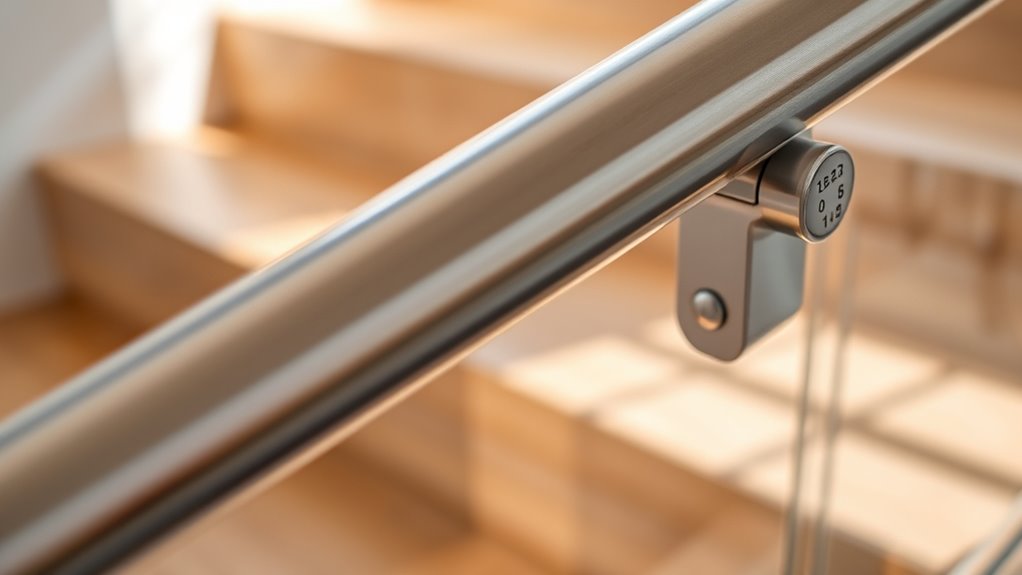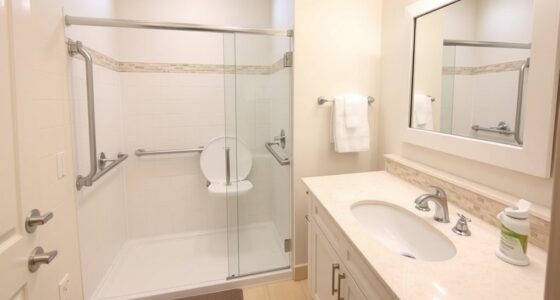To guarantee safety and comfort, set your handrails between 34-38 inches high, following standard guidelines and local codes. Focus on graspability by choosing durable, textured materials that fit comfortably in your hand, and consider adjustments for different user groups like children or seniors. Proper height and material choices improve grip, stability, and accessibility. Keep in mind that complying with regulations and testing for safety are key—stay informed to learn more about optimizing your handrails effectively.
Key Takeaways
- Handrail heights typically range from 34 to 38 inches for optimal safety and compliance with ADA standards.
- Proper graspability requires handrails to have an ergonomic diameter and textured surface for secure grip.
- Consider user groups—children, adults, seniors—when determining appropriate handrail height and design features.
- Materials and textures should enhance grip, especially in environments prone to moisture or heavy use.
- Regular testing and maintenance ensure handrails remain effective, safe, and compliant over time.
Understanding Standard Handrail Heights
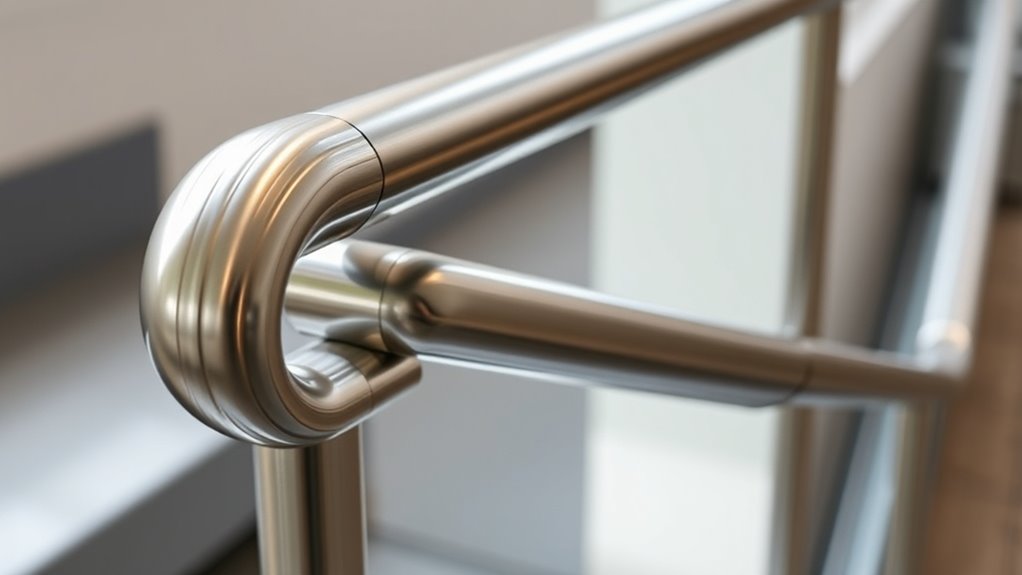
Have you ever wondered what makes a handrail comfortable and safe to grip? Understanding standard handrail heights is key. Historically, standards have guided the ideal height to guarantee safety and usability across different settings. These historical standards prioritize user comfort while maintaining safety, influencing how handrails are designed today. Handrail aesthetics also play a role; a well-designed handrail blends seamlessly with the environment, ensuring it doesn’t compromise visual appeal. Most codes recommend a height between 34 and 38 inches above the stair nosing or floor, providing a balance between grip comfort and safety. Additionally, leadership skills such as attention to detail and adherence to standards are essential in ensuring compliance and safety in handrail installation. By adhering to these standards, you ensure your handrail not only looks good but also serves its primary function effectively.
Factors Influencing Optimal Handrail Height
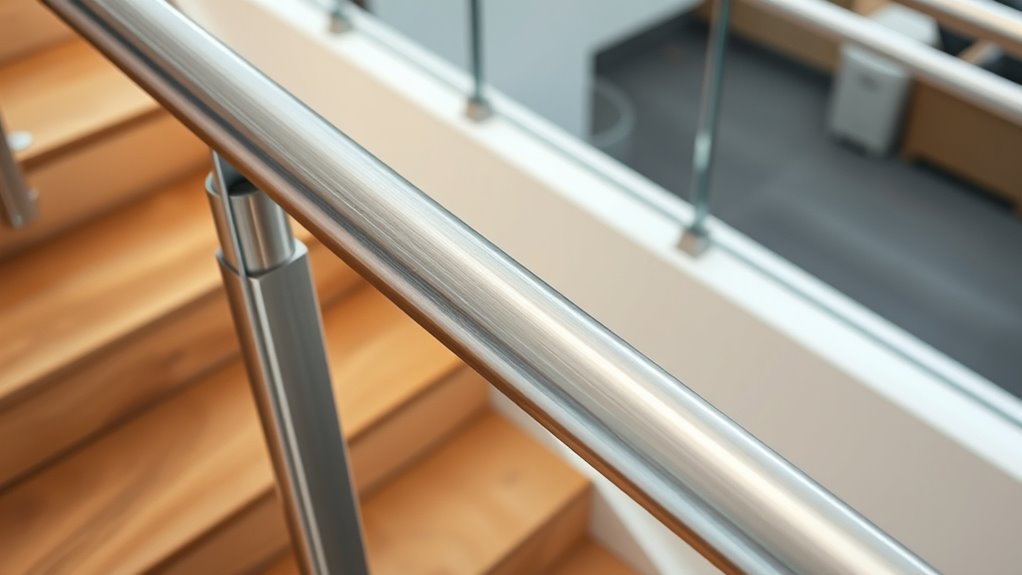
While standard handrail heights provide a useful guideline, several factors can influence the most comfortable and effective height for a specific setting. Ergonomic considerations are key; you should account for the users’ reach, strength, and typical posture to ensure safety and ease of grasp. Additionally, aesthetic integration plays a role—you want the handrail to blend seamlessly with the overall design without compromising function. For example, in spaces with high ceilings or unique architectural features, adjusting the height slightly can improve usability. Also, consider the specific needs of your environment, like accessibility requirements or aesthetic preferences. By balancing ergonomic factors with visual harmony, you create a handrail height that’s both practical and pleasing. Incorporating contrast ratio considerations can also enhance visibility and safety in various lighting conditions.
Designing for Different User Groups
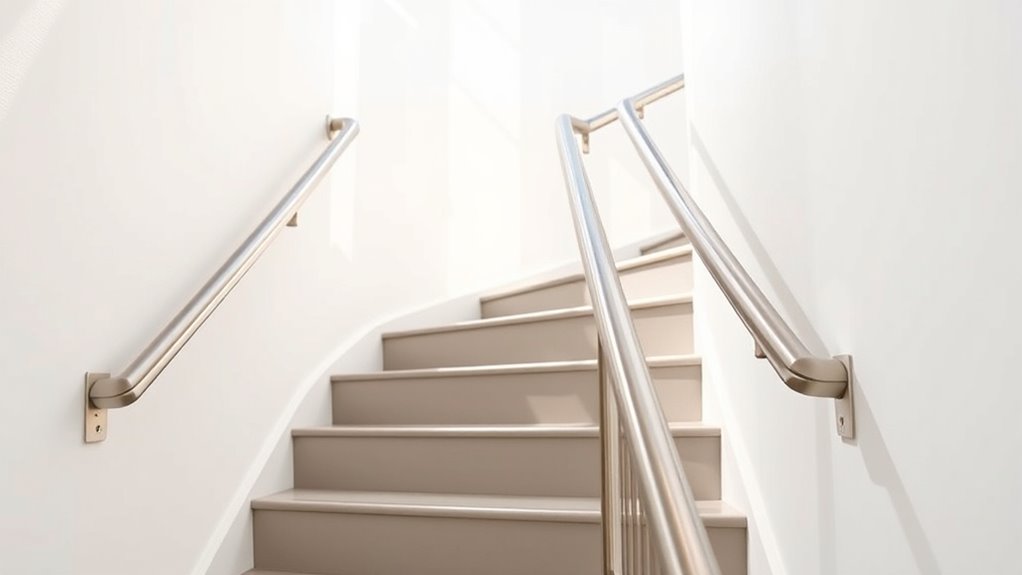
Designing handrails for different user groups requires understanding their unique needs and physical capabilities. You must consider ergonomic considerations to guarantee comfort and safety for everyone, from children to seniors. To visualize this, picture a table where each row represents a user group, and columns highlight their height, grip strength, and aesthetic needs:
| User Group | Height Range | Grip Strength | Aesthetic Needs |
|---|---|---|---|
| Children | 3’6″ – 4’0″ | Moderate | Playful, colorful |
| Adults | 4’8″ – 6’0″ | Strong | Modern, sleek |
| Seniors | 4’10” – 5’4″ | Reduced | Soft, warm tones |
Adjusting handrail height to suit different user groups ensures accessibility and safety are maintained across all ages and physical abilities.
Graspability Features and Their Importance
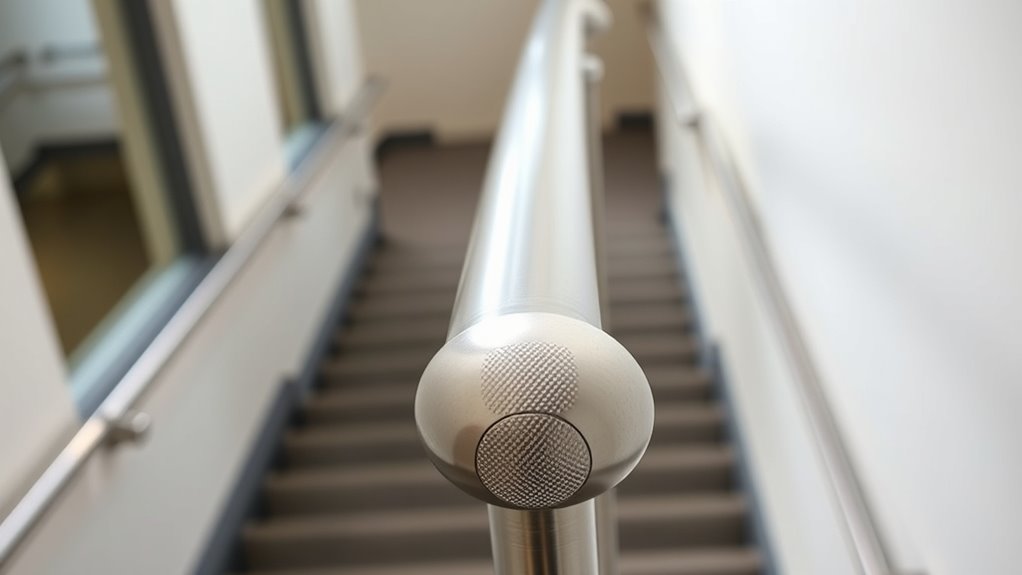
Graspability features are essential to guarantee that handrails are usable and safe for all users. An ergonomic grip ensures your hand comfortably conforms to the rail, reducing fatigue and enhancing control. Good graspability provides tactile feedback, so you can sense your grip’s firmness and adjust as needed. This feedback is vital for safety, especially in emergencies or for individuals with limited strength or dexterity. Smooth, contoured surfaces and appropriate diameters contribute to these features, making the handrail easier to grasp securely. When graspability is prioritized, users experience increased confidence and safety while steering stairs or ramps. Ultimately, these features support accessibility, encouraging independence and reducing fall risks for everyone. Additionally, aquatic exercise can improve overall grip strength and joint flexibility, further supporting safe handrail use.
Materials and Textures for Better Grip
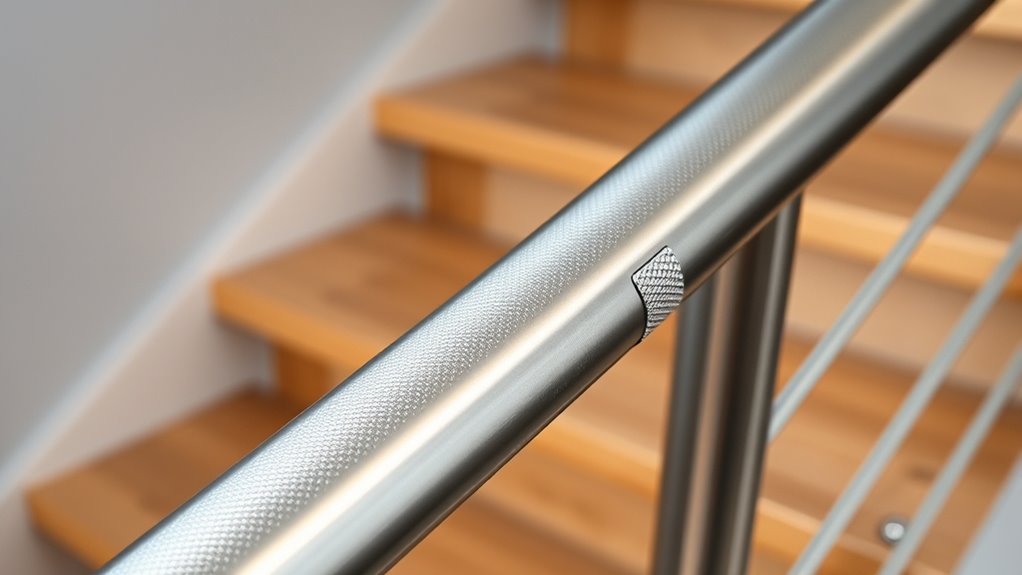
Choosing the right materials and textures plays a key role in enhancing a handrail’s grip. You want materials that offer high durability to withstand daily wear without deteriorating. For example, stainless steel and aluminum provide strength and longevity, ensuring safety over time. Textures also matter—rougher surfaces or rubberized coatings improve grip, especially in wet or sweaty conditions. While choosing these materials, consider their aesthetic appeal; a well-designed handrail should complement your space without compromising functionality. Smooth finishes look sleek but may be slippery, so balance style with grip. Additionally, selecting textured surfaces that promote a secure grasp can significantly reduce the risk of slips and falls. Ultimately, selecting materials and textures that combine durability and tactile feedback helps you maintain secure graspability, making your handrail both safe and attractive.
Adjustments for Specific Environments
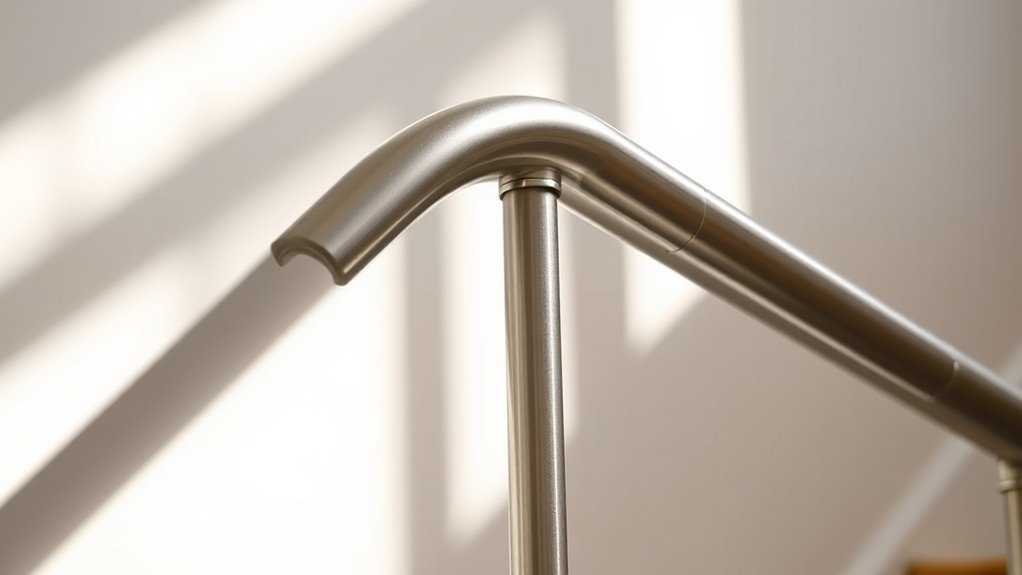
When setting handrail heights, you need to take into account whether you’re designing for commercial or residential spaces, as each has different standards. Cultural and regional factors can influence preferred heights and grasp styles, so local customs matter. Additionally, you should account for accessibility needs of special users to ensure safety and comfort for everyone. Considering the essential oils for grip comfort can also be beneficial in environments where hand grip is critical for safety.
Commercial vs. Residential Needs
Different environments demand different handrail heights and designs to guarantee safety and usability. In commercial spaces, regulations often specify higher, more durable handrails that accommodate diverse users, emphasizing safety and compliance. Residential spaces, on the other hand, allow for more aesthetic considerations, blending historical design elements with comfort. Commercial handrails typically prioritize functionality, durability, and universal graspability, whereas residential ones focus on style and personal preference. Additionally, the characteristics of a healthy handrail include ease of grasp and comfort to ensure user safety.
Cultural and Regional Factors
Cultural and regional factors considerably influence handrail design, as they shape preferences, safety standards, and functional requirements across various environments. You might find that traditional craftsmanship and regional architectural styles play a significant role in determining handrail height and graspability. For example, areas with a rich history of handcrafted woodwork may favor materials and designs reflecting local traditions. Regional building codes often incorporate cultural norms, affecting height and material choices. Additionally, architectural styles unique to the region influence the integration of handrails into overall design. Furthermore, local craftsmanship can impact the selection of finishes and detailing, ensuring that the handrails complement the regional aesthetic and cultural identity.
Accessibility for Special Users
Designing handrails for special users requires careful adjustments to guarantee safety and usability across various environments. You should consider assistive technology to enhance graspability, such as textured surfaces or adaptive grips, which help individuals with limited dexterity. Ergonomic design plays a vital role in ensuring the handrail fits comfortably in different hand sizes and strengths, reducing strain and increasing safety. Adjustments might include lowering or raising height, adding extensions, or using contrasting colors for better visibility. These modifications ensure that users with disabilities or limited mobility can navigate spaces independently and confidently. Always evaluate the specific needs of the user group and environment to implement effective, inclusive solutions that promote accessibility for everyone. Additionally, understanding the financial impact of entertainment industries like WWE Raw can inform better resource allocation for accessibility initiatives in public spaces.
Compliance With Building Codes and Regulations
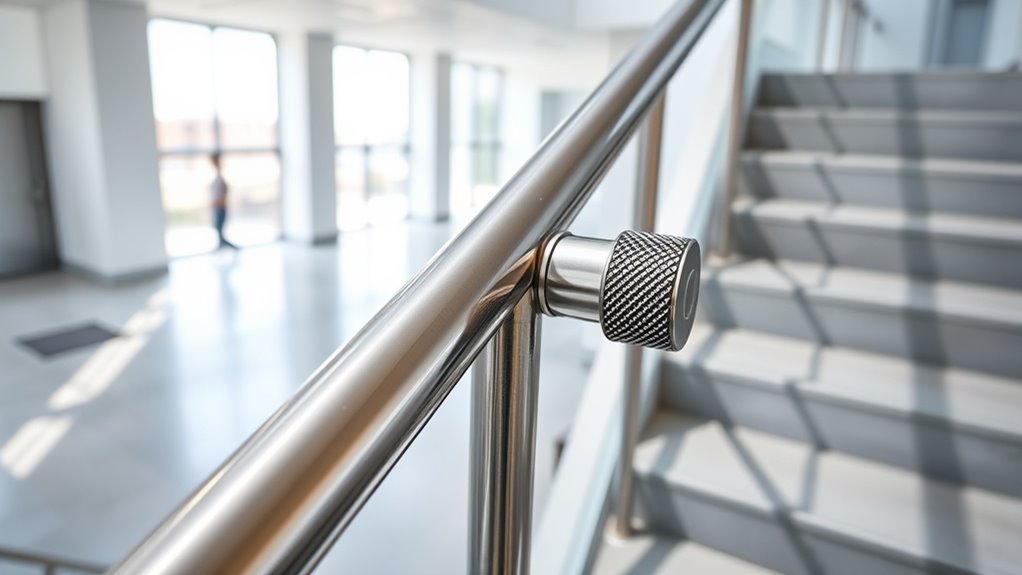
You need to guarantee your handrails meet local code requirements and ADA accessibility standards. Failing to comply can lead to safety issues and legal penalties. Staying updated with building regulations helps you create safe, accessible spaces for everyone. Incorporating attention to detail in your compliance efforts ensures that all aspects of the regulations are thoroughly addressed.
Local Code Requirements
Adhering to local building codes is essential when selecting handrail heights, as these regulations guarantee safety and consistency across structures. Local code requirements specify minimum and maximum height ranges to ensure proper graspability and prevent accidents. To comply, you should review your area’s safety standards before installation.
Key points include:
- Verifying specific height measurements mandated by local codes
- Ensuring handrails meet strength and stability criteria
- Using approved materials that comply with safety standards
- Consulting with building inspectors to confirm compliance
Following these guidelines helps avoid violations and enhances safety. Staying informed about local code requirements ensures your handrails provide the necessary support and meet all legal standards, ultimately protecting users and your property.
ADA Accessibility Standards
Are your handrails compliant with ADA accessibility standards? Ensuring compliance means following specific guidelines for height, graspability, and placement. The standards emphasize ergonomic design, so your handrails should be easy to grip for all users, including those with limited hand strength. ADA also considers aesthetic considerations, encouraging integration with your overall building design without compromising accessibility. You need to verify that your handrails meet the required height range—generally between 34 and 38 inches—and that they are continuous and unobstructed. Properly installed handrails improve safety and usability while aligning with building codes. Staying current with ADA standards not only helps you avoid legal issues but also demonstrates your commitment to inclusive design for everyone.
Updating Building Regulations
Updating building regulations guarantees that your handrail installations stay compliant with current standards and legal requirements. Keeping up with evolving codes ensures safety, accessibility, and adherence to legal obligations. Historical guidelines may have influenced past standards, but modern regulations often incorporate new safety and usability insights. When updating regulations, consider aesthetic considerations to maintain visual harmony within your design. Staying current helps you avoid penalties and ensures your handrails meet the latest graspability and height standards.
- Review recent amendments to local building codes
- Incorporate changes related to historical guidelines and safety
- Balance aesthetic considerations with functional requirements
- Consult professionals to interpret new compliance rules
Testing Handrail Effectiveness and Safety
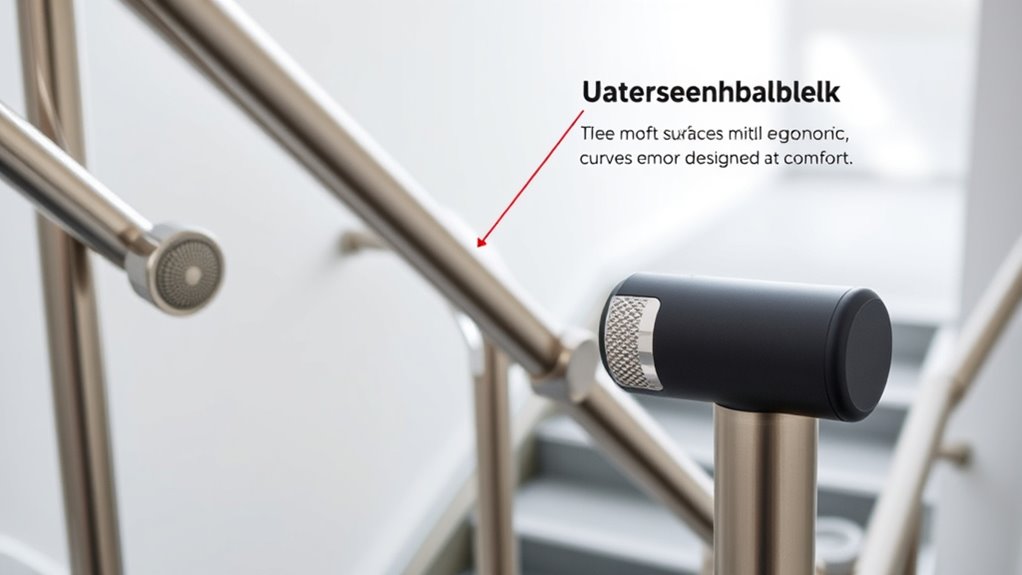
To guarantee handrails effectively prevent falls and provide reliable support, testing their effectiveness and safety is essential. You should assess the ergonomic grip to ensure users can grasp the handrail comfortably and securely. This involves checking that the shape and texture promote a firm hold, reducing slip risks. Additionally, testing material durability is vital; you need to verify that the handrail withstands environmental factors, regular use, and potential impacts without degrading. Conducting load tests confirms the handrail can support weight without failure, while slip resistance assessments ensure safety during wet or greasy conditions. Regular testing helps identify weaknesses early, allowing for timely repairs or replacements. By focusing on ergonomic grip and material durability, you guarantee your handrails provide consistent safety and support over time.
Tips for Maintaining and Updating Handrails
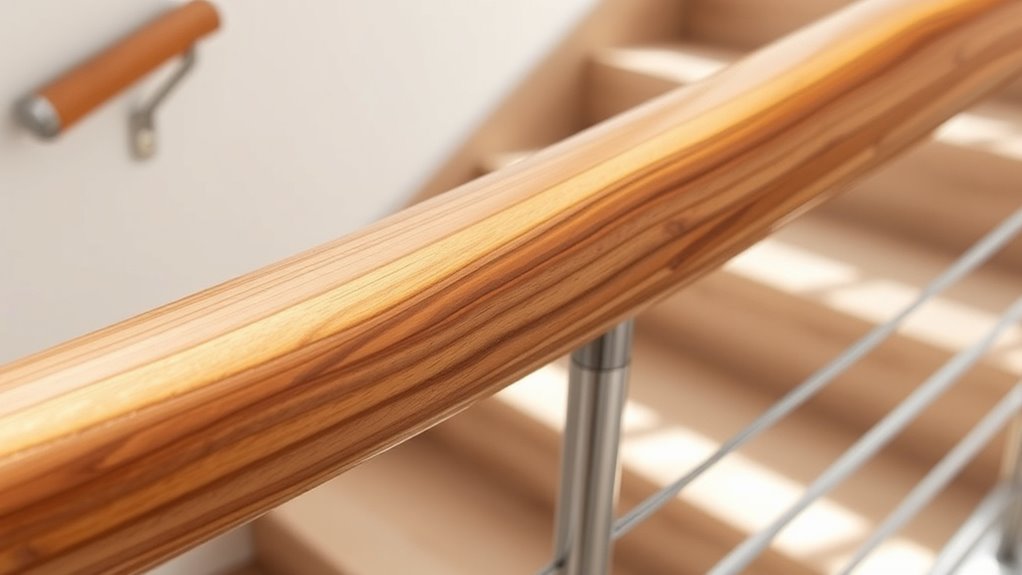
Regular maintenance and timely updates of handrails guarantee they continue to provide safe support. To keep handrail aesthetics appealing and preserve historic value, inspect regularly for damage, corrosion, or looseness. Clean surfaces to prevent grime buildup, and repair or replace worn components promptly. When updating, consider historical preservation guidelines to maintain authenticity. To ensure safety and appearance, consider these tips:
- Use durable, matching materials for repairs
- Refinish or repaint to enhance aesthetics
- Update handrail mounting for stability
- Consult preservation experts for historic features
Frequently Asked Questions
How Do Handrail Heights Vary Across Different Countries?
You’ll notice that handrail heights vary across countries due to cultural standards and architectural diversity. In some places, regulations set specific height ranges, while others adapt based on local building practices. You might find that in Europe, standards lean toward certain measurements, whereas in the US, guidelines differ. These variations make certain that safety and comfort, reflecting each region’s unique approach to design and cultural preferences.
Can Adjustable Handrails Accommodate All User Needs Effectively?
Of course, adjustable handrails are the ultimate solution—who wouldn’t want perfect customization flexibility? In reality, they often fall short of user-specific design needs, making you wonder if they’re just a fancy gimmick. While they aim to accommodate everyone, the reality is that their effectiveness depends on precise adjustments, which can be tricky. So, unless you enjoy constant tweaking, they might not truly meet all user needs effectively.
What Are the Signs of a Worn or Unsafe Handrail?
You’ll notice a worn or unsafe handrail if you see visual deterioration like peeling paint, rust, or cracks, which indicate aging and reduced strength. Additionally, check for loose fittings or wobbling when you grip or lean on it, as these signs suggest instability. These issues can pose safety hazards, so it’s vital to address them promptly to prevent accidents and guarantee the handrail remains secure and reliable.
How Do Weather Conditions Affect Handrail Durability and Grip?
Weather conditions can considerably impact your handrail’s durability and grip. Rain, snow, and humidity promote corrosion resistance issues, weakening the metal over time. Extreme cold or heat can cause materials to expand or contract, reducing slip resistance. To stay safe, choose handrails made from corrosion-resistant materials and guarantee they have textured surfaces for better grip, especially in wet or icy conditions. Regular maintenance helps keep your handrails secure and reliable.
Are There Emerging Materials That Improve Graspability and Safety?
Emerging materials like textured composites, silicone coatings, and anti-slip metals are revolutionizing handrail safety. These innovative materials enhance grip, resist weathering, and improve overall safety, ensuring you can hold on securely regardless of conditions. By adopting these advanced options, you benefit from better control, increased durability, and peace of mind. As technology advances, expect even more solutions that prioritize your safety and comfort in every environment.
Conclusion
Ensuring your handrails are the right height and easy to grasp can considerably boost safety and accessibility. Did you know that falls on stairs are a leading cause of injuries, especially among seniors? By choosing the right materials, following code standards, and regularly maintaining your handrails, you create a safer environment for everyone. Keep these tips in mind, and you’ll help prevent accidents while making your space more user-friendly for all ages.
